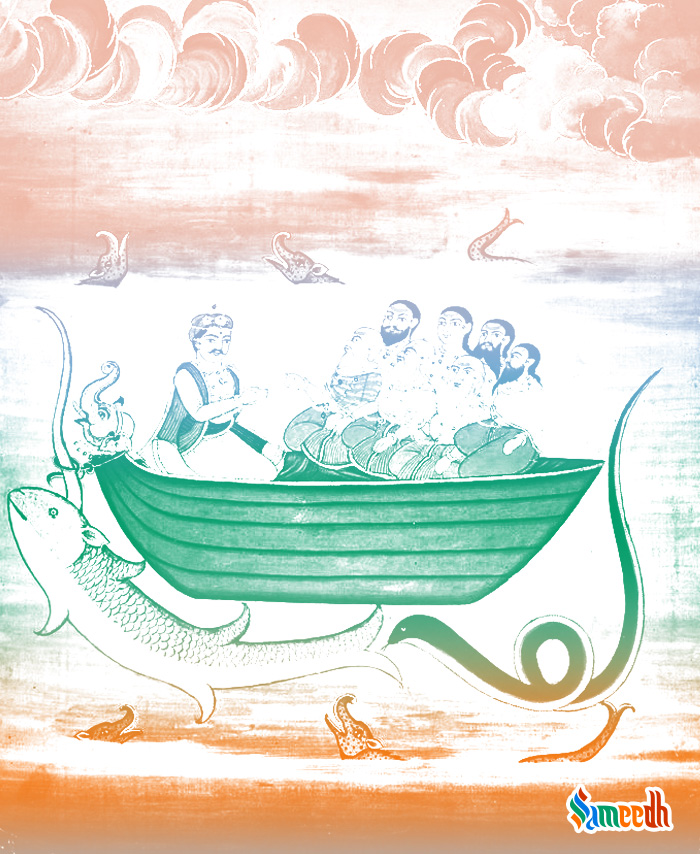Manu Rishi is the one who saved humanity as well as all other flora and fauna from the great deluge; and he repopulated the world when the waters receded. Sage Manu, in Hindu mythology, is considered one of the ancient and significant progenitors of humanity. There are several Manus mentioned in different cycles of time, each representing a specific era or Manvantara. The term “Manu” is derived from the Sanskrit word “Manav,” which means “human.”

Manu and Saptarishi; Image Source: Indian Miniature Paintings
Manu is one of the most well-known seers in India because of one fact that each and every generation is considered a progeny of Manu. Hence, the Sanskrit word for mankind or humans is Manav – which means the children of Manu. According to Hindu cosmology, Svayambhuva Manu and his wife Shatarupa are believed to be the first human beings created by Lord Brahma, the creator of the universe.
He is not one of the Saptarshi, but he is revered across India or Aryavart. According to Manu, Aryavart extends from the Himalay in the north to the Vindhya of Central India in the south and from the sea in the west to the sea in the east. Some researchers believe that the legend of Mannus – belonging to Germanic tribes, the legend of Minos in Greek mythology, and the legend of Manu in Vedic Gods – could be connected.
It is believed that there are 14 different Manu who presides over one Kalpa each. The 7th Manu – Vaivaswat (son of 12th Aaditya – Vivaswana) is considered to be Manu at present. His timeline is considered to be 10,000 years ago, coinciding with the timings of the Ice Age.
There are also some connections with the Jain scriptures, as per Bhagwat Puran. There are legends of 14 Jain scholars which seem similar to 14 Manus. Also, the 14th scholar called Nabhi Rai is considered to be the father of 1st tirthankar – Adinath.

Manu with Fish; Image Source: Artist Manaku
Every culture in the world has a parallel story of ‘the great deluge’ and subsequent floods or Pralay. Be it African, Mesopotamian, Inca, Abrahamic, Chinese, Greek, and Indian culture – a story similar to Noah’s ark can be found.
There are many interesting parallels between the story of Vaivaswat Manu and stories of flood myths. The story of Manu is also associated with the great deluge or flood (similar to the biblical story of Noah’s Ark). Lord Vishnu, in the form of a fish (Matsya Avatar), guided Manu’s boat to safety, carrying with it the Saptarishi (seven great sages) and samples of all living beings.
With the help of experts from coastal tribes and fishermen communities – Manu created a huge ship to travel eastwards as per Bhagwan Vishnu’s warning about floods. He was about 400 years old at that time. This ship was so huge that it could host a huge number of animals and birds along with commodities and other things.
In the ocean, Bhagwan Vishnu takes the Matsya Avatar and guides Manu to steer through the rains and waves. This is noted in many puran such as Matsya Puran, Bhagawad Puran, etc. The legends say that after the waters of the flood recedes, Manu and the seven sages repopulate the earth. All the humans are considered to be the children of Manu and Ananti.
Manu is believed to be the creator of many texts for social upliftment including – Manava Grihyasutra, Manava Sulbasutra and Manava Dharmashastra.
Manusmriti – sort of collection of laws for humans. It is officially known as Manav Dharm Shashtra or the collection of duties for a human. It has detailed guidance about dharma, sacraments, the study of the ved-puran, marriage, hospitality, funeral rites, dietary restrictions, pollution, purification, rights of women, and the laws for kings.
There are some places that are connected with Manu historically. They say the place where Manu used to live was called ‘Manu Aalaya – which is known today as ‘Manali’ – one of the most popular tourist destinations in Himachal Pradesh.
Sage Manu is considered a legendary figure who played a crucial role in the early stages of human civilization. His teachings and guidance are reflected in the Manusmriti, which addresses various aspects of life, including law, morality, and societal conduct.
The significance of Sage Manu extends beyond his role as a progenitor; he is venerated for his contributions to the cultural, ethical, and legal foundations of Hindu society. Manusmriti remains an important text for understanding the principles of dharm (righteousness) and social order in Hinduism.